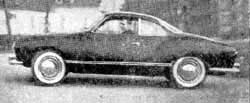October 1956 issue of Science and Mechanics - The Magazine That Shows You How, Vol. XXVII, No. 5
Will the GHIA Outperform the Volkswagen?
|
Left, Rounding out a sharp turn, the low-slung Ghia-Karmann coupe leans only 2º. This compares to a side-sway angle of 3º fog the regular '55 Volkswagen. Average for the nine 1956 domestic cars we have tested was about 4.4º. Above, Ghia top speed is 71 mph compared to 67 mph we recorded on our 1955 VW test sedan. One reason is reduced wind resistance of Ghia's smaller frontal area. |
|
As almost any Volkswagen owner will tell
you (again and again! ), there is nothing
wrong with the little car. Its air-cooled
flat-four engine is a marvelous mill indeed. The
torsion bars and individual wheel suspension
hanging the wheels give a superbly sure ride. The
German-assembled unit body and chassis is precision personified. Its jackrabbit maneuverability
makes domestic cars look like overgrown dinosaurs. And - donnerwetter! - did you ever see
such gasoline economy!
Ask these owners about the VW's bulgy body styling, however, and you'll usually get either a half-hearted phrase like "It's very functional." Or a change of subject. Or a mess of silence. Perhaps that's why the people who make Volkswagen decided to produce the Ghia-Karmann coupe. Here's a car built with the sturdy guts of a VW, but covered by a sleek new flow of steel and glass styled by Carozzeria Ghia in Turin, Italy. Since the Ghia is basically a Volkswagen (in its mechanical heart) a comparison of our test results on the two cars makes an interesting study of the elect of a radical styling change on performance. Such chassis and mechanical changes as were made (wider belly pan and slight modifications of steering gear, front suspension and carburetor) would not in themselves alter fuel and speed performance appreciably. Will the svelte Ghia outshine the regular Volkswagen on the road? Our test figures, showing comparisons with the '55 VW (same as the '56 except for control, exhaust and finish refinements) tell the story.
|
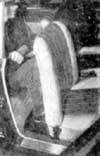
|
Space behind front seats has some room for luggage,
some room for passengers, but not a lot for either one, Rear seat
headroom la 29.5 in.; rear seat knee room 8.3 in. to 0 ins. depending
on front seat position. Back of rear seat forms hatch cover for luggage
space, folds down over seat pad; luggage space measures 37 in. wide,
22.4 in. long, 13.4 in. high. Lining is extremely rugged nubby type
used
in Volkswagen line.
|
|
Brake and clutch pedals keep close company in the
Ghia. One heater outlet from the car's engine-fan heater (blows hot air
through central floor manifold) shows a small oblong grill between
driver's feet (left). Note "L" handle on firewall; twisting it down
cuts in bottom, emergency level of gas tank; contains enough gas to get
you
to the next gas station.
|

|
|
Roadability has been improved by several modifications; the car takes the road like an electric rabbit on a dog track. Its side sway, for instance, was only 2º as compared to 3º for the regular Volkswagen. The reduction comes from the Ghia's lower center of gravity, mainly gotten by dropping the front seats; the mounting angle of the steering wheel has been reduced too. The front suspension of the Ghia also differs from thee Volkswagen. A front stabilizer shaft has been added. How do you lash more gas mile age, acceleration and higher top speed out of same machinery, as was done with the Ghia? The true automotive engineering approach (see Tech Talk) is to streamline the body more completely and especially to shave down the car's frontal area. Our top-speed test figures were 71 mph for the Ghia compared to 67 mph for the Volkswagen. In this case, it looks as if the stylists did all right by the engineers for a change. Our fuel-consumption tests (see Table A) show that the Ghia is generally more of a fuel miser than the '55 Volkswagen and definitely more than the 1956 domestic cars we've put through the paces. Note that in Table A the Ghia had a better economy for the overall, and city-country tests than did the '55 Volkswagen but about the same for the traffic test. This apparent inconsistency is the result of the many accelerations in the traffic test. The traffic figure is an average for level-road driving plus stops and starts. If the accelerating charge of the carburetor were slightly rich, then this effect could nullify the good level-road performance for fuel economy at, for example, 30 mph.
|
TABLE A - GASOLINE MILEAGE FROM PERFORMANCE TESTS
This analysis is verified by our acceleration tests which
gave a definite edge to the Ghia over the '55 Volkswagen (see Table B).
Among other things, the better acceleration does suggest a richer
carburetor charge in the Ghia. (The VW carburetion system is slightly
changed for the Ghia as indicated in the engine photo.)
TABLE B - ACCELERATION - GHIA VS. 1955 VOLKSWAGEN
| Incidentally, the Instruction Booklet for the Volkswagen is a shining bit of truth in these days of whopping performance claims for stock cars in every kind of automobile performance contest. Table C shows you how closely our test figures match the Volkswagen claims. |
TABLE C
| Top | Hill | Climbing | Brake | 0-50 MPH | |
| Speed | 1st gr | 3rd gr | HP | Accel | |
| Advertised value | 72 mph | 34% | 10.5% | 30.0 hp | 22.0 sec. |
| Our test value | 71 mph | 38% | 9.0% | 29.5 hp | 20.1 sec. |
|
Although many motorists talk
about wanting good fuel consumption, few people seem to put fuel
economy high on their car shopping lists. Maybe it's because they
pooh-pooh fuel economy : as a way of really saving money with a car.
The fact is you can save a sizable amount in a year -- enough for a
week's vacation perhaps -- if your car takes its gas in sips instead of
gulps.
Say, for comparison's sake, that you drive an American make of car 10,000 miles in a year's time and that your overall mileage for all kinds of driving is 11.8 mpg (see Table A). At that rate, you'd use 854.7 gals. in a year. And at, let's say, 30< a gallon, your yearly gasoline bill would be $254.24. Fuel costs on the Ghia are a different story. Its overall gas mileage is 28.1 mpg. So if you drove 10,000 miles, you'd use 355.5 gallons. And you would spend $106.65 for it at 304 a gallon. Thus, driving a Ghia instead of the average domestic car would save you $147.59 per year in gasoline alone. If the American car required premium gas, savings would be even greater. |
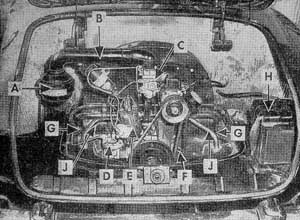 | Nobody in here under the hood but the gas tank, spare tools and luggage apace. Air-cooled engine is in the back. Space is shallow at the rear since general front seat legroom runs in beneath it. Tank filler pipe is made wide to allow visual checks of gas level. Car has no fuel gage. |
| Standard 36-horsepower, air-cooled, , flat-four opposed engine rides in rear compartment. To lower the deck in helping with Ghia's streamlining, the (A) air cleaner has been taken off the car top where, it rides in the VW and connected by a (B) long tube to the (C) carburetor. The air bleed let was also changed. Other parts' include (D) fuel Pump, (E) distributor, (F) crankcase oil Dip stick, (G) sparkplugs, (H) battery, and (G) engine mount braces. |
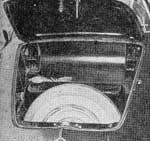
|
|
Braking is a test in which the Ghia thatches its VW cousin in going to the head of the class. Brake pedal effort did not double in 12 fast consecutive stops on either the Ghia nor our test Volkswagen. The VW pedal pressure varied from 50 to 52 lbs. over the 12 stops. On the Ghia (see brake-fade test on test chart) pedal pressure started at only 34 lbs. and rose to about 38 lbs. This lesser effort could be due to softer linings or less "cooking" of the brake linings on the Ghia. |
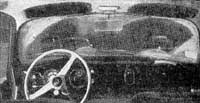 | Electric windshield wipers run at one fairly slow speed, but they overlap in center to eliminate blind spot usually found on domestic cars. Instruments include, left to right: Choke knob (top) ignition switch, speedometer, hood release knob (shows beneath horn button), clout, light switch, wiper switch. White knobs at far right and left control ventilators; radio fits in center. |
|
Many comments made about the Volkswagen in our previous test apply here too. Some things have been improved. Vision-obstructing posts are slimmed to a minimum. Visibility out of the glassy sides, front, and back is far better than through the VW's smallish windows. The windshield is 47.2 in. wide, 16.1 in. high; the rear window is 43.3 in. wide; 16.9 in. high. And here's warming news for cold-climate drivers. This coming winter season you'll be able to buy a new gasoline heater for your Ghia VW that fires up faster than the built-in heater which is now standard equipment. Price, about $116.28. Some things have remained about the same. Those air-cooled four opposed cylinders in the trunk still turn out the same horsepower as on the regular sedan (36 hp). And during fast acceleration the engine still cries loud enough to make you think that you're being shadowed by a couple of power mowers. But it does seem a bit quieter than the '55 Volkswagen we tested. Then, too, at least one thing has been made worse, namely, back seat headroom which has been squashed down to allow the sleeker styling. No wonder this back bench is sometimes referred to by VW clansmen as "the mother-in-law's" seat. The fact is, the Italian designers of this body probably feel they were making a concession by having a back seat at all in a sports-style car. There are many advantages to owning a small foreign car like the Ghia - especially if it's built as the Ghia is. |
SPECIFICATIONS - GHIA
|
ENGINE: Horizontal Opposed, Overhead, 4 cylinder. Bare 3.031
in.; stroke 2.520 in.; advertised maximum brake horsepower 36 at 3700
rpm. Taxable horsepower 14.7. Advertised maximum torque 56 lb ft.
Compression ratio 6.6 to l. Piston displacement 72.740 cu in. Fuel
specified regular.
TRANSMISSION: 4 Forward Speed Syncro-Mesh; Rear axle ratio: 4.4:1. STEERING: Turning circle 36 ft, curb to curb. Torque to turn 10 lb ft static; 2.6 turns lock to lock; EXTERIOR: Wheelbase 94.5 in. Overall length 161 in. Overall width 62.8 in. Overall height unloaded 51.5 in. Curb weight 1785 lb (with 10 gal gas, oil and water). Minimum road clearance 6.8 in. at rear shock. INTERIOR: Headroom: front seat 34.5 in. and rear seat 29.5 in. Legroom: front seat 48 (max.) in. and rear seat 34 in. Kneeroom: rear seat 8.3 in. to 0 in. Hiproom: front seat 55 in. and rear seat 42 in. Total front seat adjustment at floor: 7.5 in. forward or back; 0.5.in. up or down. VISIBILITY: Windshield area 726 sq in. Rear window area 731 sq in.; from eye of 5 ft 8 in. driver and seat in best position, distance from driver's eye to road over left front fender is 17 ft 10.5 in. (or 11 ft 11 in. blind distance to car); over hood center 18 ft 5.5 in. (or 14 ft 8.5 in. blind distance to car); over right front fender 21 ft. 11 in. (or 16 ft 1 in. blind distance to car). EQUIPMENT: Battery. El 6-volt, 66-amp hours, located right of engine compartment. Tires 5.60-15 ply 4; recommended pressure 17 psi front, 24 psi rear. Springing: front torsion bar, rear torsion bar. Frame pan type with tubular center. CAPACITIES: Fuel tank 10.5 gal. Crankcase 2.7 qt. Cooling system (air cooled). Transmission 5.3 pt. Luggage compt. dimensions 34 by 16 by 8 in. (less tire displ. and tools). |
|
There are plenty of places you can wangle into with the 161-inch long Ghia that you'd have to pass up with the big U.S. makes. Chevrolet, for example, is 198 in. long; Rambler, 191.4 in. (but the little Metropolitan is only 149.5 in.). Maneuvering in traffic is easier. Licenses for lower-powered models such as the Ghia are cheaper. And remember you don't have to buy any anti-freeze for the air-cooled engine. Both the exterior and interior body work on the Ghia is beautiful and done with a minimum of chrome except where needed for rub rails, hub caps, and moldings. You'd find disadvantages, yes. Servicing can be a headache sometimes, but at least the Volkswagen line, leaping ahead in popularity throughout the United States, has one of the most complete arrays of service installations of any import. And they back up their cars with one of the most enlightened and well-planned servicing policies we have ever seen. The New York port-of-entry price for the Ghia is $2395 (Chicago P.OZ. is $2460). Some of the available extras include a radio for $75, full leatherette upholstery for $37.50, chrome wheel rings for $22.50, and white sidewalls for about $25. |
Driver's Observations
|
ROADABILITY: So little dip and sway you'd swear she was gyro-stabilized. Light weight and small wheelbase do, however, let it skitter a bit on cobbly surfaces, though torsion bars snub down any amplification of bounce. Tracking superb. Wheels show bulldog grip on curves. Wind wander negligible. Steering quick (2.6 turns lock to lock) .but turning circle radius not as good as you knight think for this small car. Won't turn mound in an average-width two-lane city street. Brakes smooth and positive. Down-pitch almost nonexistent. RIDING AND DRIVING COMFORT: Pleasant cockpit feel in front. With your knees on either side of front bucket seat, rear seat will do in a .pinch, which it does. Front seat head--room okay, but you have to squinch down in rear seat - no headroom to spare. Rear seat will take two - possibly three - 6-year olds nicely, even with 6-ft. driver's legs comfortably stretched out in the front seat. Maneuverability excellent; can drive into parking spot forward. Both front and rear vision excellent compared irregular VW sedan. Windshield car- posts slanted back help in front; large rear window instead of the regular VW's peekaboo port helps rear vision. Vibration moderate. Noise level at highway speeds low - through gears noisier - but seems a little quieter than VW. Shifting smooth in 4 forward gem H-pattern. Have to press down to get shift into dogleg reverse position; shift stick sometimes balks at dropping in. Finding slot for this can be balky business at times, though transmission action is generally smooth and positive. INSTRUMENTS AND CONTROLS: Nice-sizeed steering wheel but thigh of 6-footer tends to strike it when lifted up to apply brake. Roller gas pedal not tiring as we speculated it might he on VW. Brake and clutch pedals small and close together; gas roller also close. So teach your feet how to differentiate when you drive a Ghia. Controls simple. Directional signal better than on 1955 VW - will not fly over into opposite position; also hard to trip accidentally. Gages easy to read but chrome frames mound them seem needless. So does shiny dash top. Lights only for amp and oil. Single (but easy to see) blinking red light at top of speedometer for directional signal. Dome light in center of head-liner above windshield operates when doors open. Ignition-key starting works well though you have to throttle up high in chilly weather for engine to catch. Handbrake holds quite well Door and window handles well placed, but arm rest pull is so far back, your elbow gets caught between door and seat when closing. Grab handle on right above dash handy to hang onto but would make a nice teeth remover in a crash. Glove compartment small, but pockets on both doors probably give more storage room in front seat than big American models. Catch on test car's glove compartment somewhat fussy. Both smoked celluloid-style sun-shields hung on single front bar. Hard to see through, distort, distort and jitter, and can't be swung to side. Vent knobs on either side under dash. MISCELLANEOUS: Rear engine hood release in rear seat a nice touch. Test car showed battery corrosion due to rear-deck drainage onto battery. Some faulty caulking behind rear storage seat upholstery and few cracks on one section of weather-stripping marred otherwise beautiful and precise finishing job on both interior and exterior. |
TECH TALK
|
WHY does the fuel consumption for all cars (mpg) decrease rapidly at
high speeds? The answer is that the resistance offered by the air, and
by the road, increase with speed at a rapid rate. A typical formula for
level-road horsepower without wind is For usual values of the drag coefficient (0.52) and the density (0.07), you can round out the equation to: 
At low speeds (20-30 mph) it is the weight of the car that requires power; at about 40 mph, the roiling and the atmospheric resistance are about equal; but at 60 mph the atmospheric resistance is double the rolling resistance! (For American cars: 4000 lb., 25 ft^2 area). The typical form of the horsepower curve for the engine and gear train is also shown in the figure. Note' that the intersection "A" represents the maximum speed of the car. (Of course, a good tail wind will nudge this higher.) More available engine power at high engine speed also gives a higher speed. But the true engineering approach for efficiency is to reduce the drag coefficient (C) of the automobile by streamlining and, also, to reduce the frontal area (A). Although the foregoing equations are approximations, let us use them to calculate the top speed of the Ghia. W=1785 lb, A=20 ft^2, and HP =29.3 (axle horsepower according to our tests) Thus: The calculated answer is thus 72.5 mph. Our actual test result was 71 mph. And VW's claim for the Ghia is 72 mph. The closeness of our calculated answer attests that these approximate formulas are not too inexact at the low top speed of the Ghia. Note, too, in the figure, that the maximum brake horse-power developed by the engine can be attained at top speed only if point "A" coincides with the maximum-hp point. The rear-end gearing in most cars causes this to be true. But maximum car speed often occurs with the engine over its power peak (the case shown in the figure). A tail wind brings down the resistance curve and "A" shifts to higher speeds. A head wind raises the resistance curve and point "A" shifts to lower speeds. Incidentally, don't confuse the calculated top speed value given above with the MPH we list under Performance Factors. This MPH, corresponds to the advertised peaking speed of the engine - and it is j calculated from the advertised peaking speed and the 'rear axle ratio., It can be either greater or less than the maximum top speed obtained by test. If it agrees, then you, know you have essentially the right rear axle for top speed. |
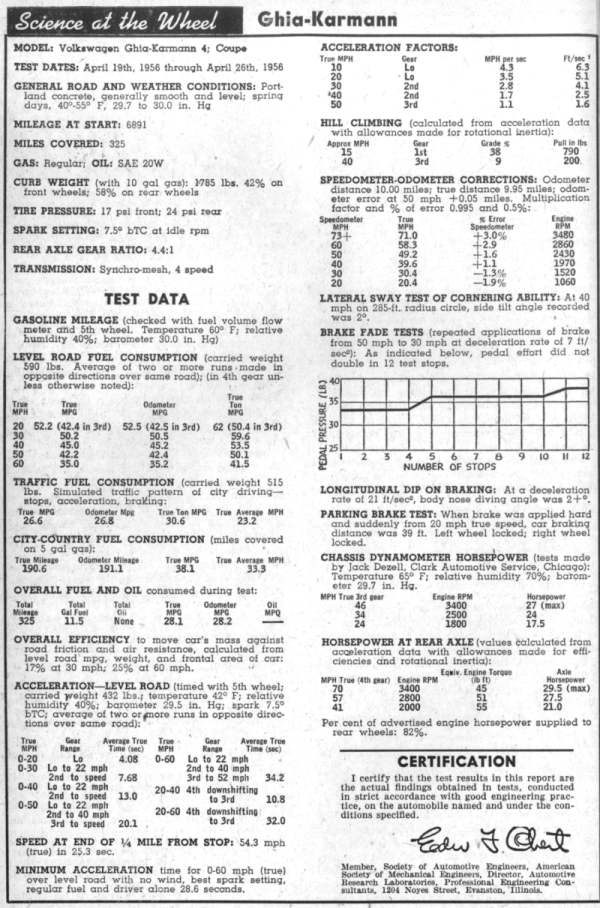
|
76 mph (true) at maximum advertised horsepower and 41 mph at max adv torque. Engine rpm at 60 mph (also revolutions per mile) 2940 rpm. Average piston speed at 60 mph (also, ft/mile) 1235 ft/min. Cu ft per minute of mixture at 60 mph (also, cu ft/mile) 61. Maximum engine horsepower (adv) per ton of car (curb weight) 40.1. Maximum engine horsepower (adv) per cu in. displacement 0.495. Power performance factor (a weighted average of CR, piston displacement, and curb weight): 62. |
For Women Only
|
MY husband says the ladies asked for this one. According to him, they take a fine, hard-working car
like the Volkswagen and insist on having it restyled so
it won't be so bug-like. He admits that the resulting
Ghia is much better-looking, but points out it costs
more, has less headroom in back, and that it's harder to
get into and out of the Ghia.
He might have a point - were it not for the fact that every Ghia I have seen on the street was being driven by a man! I must admit that I am sold on the Ghia's looks. It has the appearance of sensible richness about it you find in some good clothing. It also runs beautifully, too, and maneuvers like a dream. And the styling results in driver's vision being 100% better than it is in the Volkswagen sedan. Getting the hang of this car won't be much of a problem unless you never did learn how to shift gears. Shifting through gears will, of course, keep you busier driving than would be the case with a car with automatic transmission. Actually, I believe that it makes me a safer driver since I pay more attention to the driving. |

